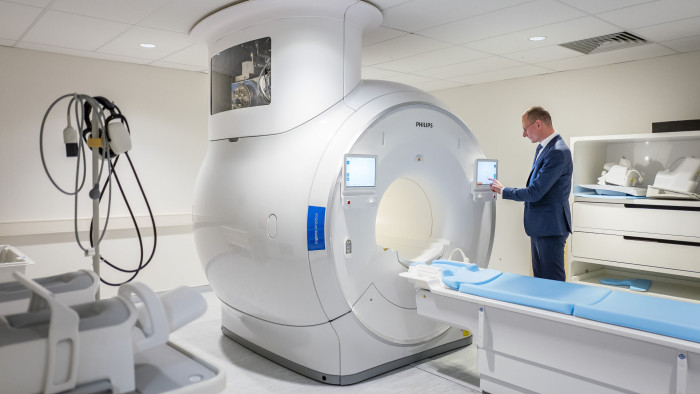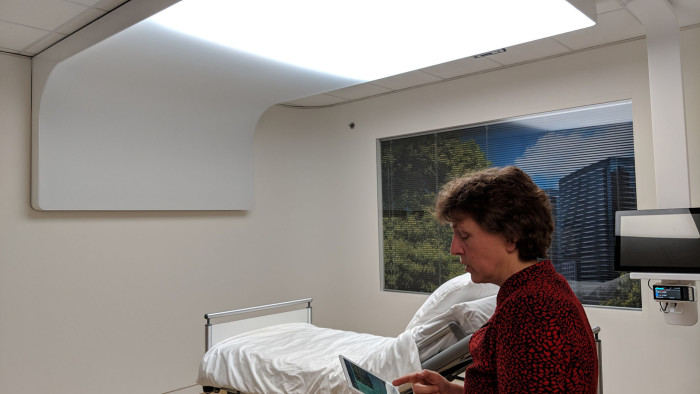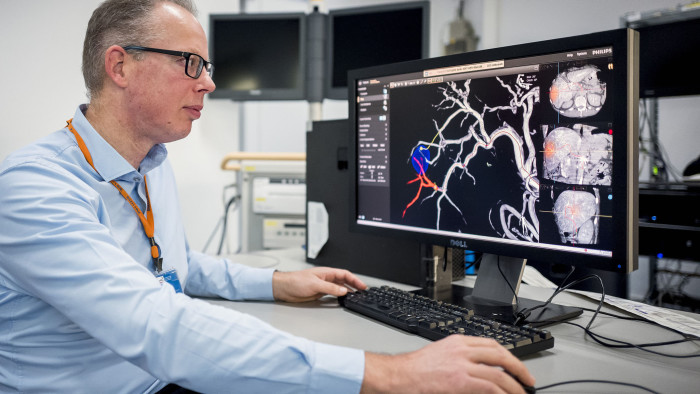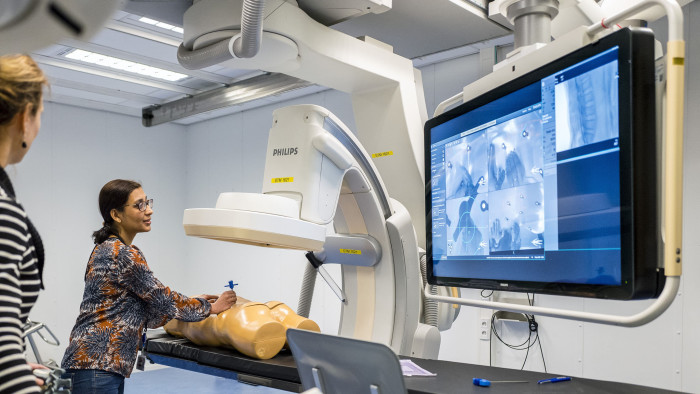High-tech hospital R&D focuses on controlling costs

Roula Khalaf, Editor of the FT, selects her favourite stories in this weekly newsletter.
In the bowels of a building at Philips’ research and development centre in Eindhoven in the Netherlands, the hospital of the future is taking shape.
A hospital bed sits under a specially-installed canopy-style ceiling which changes colour, simulating an “accelerated sunrise” that will bring a post-operative patient gently back to wakefulness in the morning, explains Gaby Meekes, chief technology officer at VitalMinds, which she describes as a “start-up within Philips”.
This is not simply about enhancing the patients’ experience: there is an urgent clinical reason to discover ways of countering the confusion that can afflict someone confined to an intensive-care unit.
She explains that up to 80 per cent of ICU patients suffer delirium, due not only to the severity of their illnesses and medication levels but also as a result of a disorientating environment, sleep deprivation and immobility.
Such patients suffer a three times higher mortality rate six months after leaving the hospital, and are nine times more likely subsequently to suffer dementia and other forms of permanent cognitive impairment.

A trial in Berlin’s Charité hospital, however, found that the incidence of ICU delirium was only 46 per cent among patients treated in the modified rooms compared with 76 per cent in standard rooms, says Ms Meekes.
The approach holds promise for cash-strapped health systems which are increasingly seeking to shift from “volume” to “value” in the way they treat patients. The backdrop is an ageing global population, a rise in chronic, often lifestyle-related, conditions and an explosion in costs. In the US alone, the cost of treating delirium-affected patients is $145bn a year.
Henk van Houten, chief technology officer, says that in the 34 years he has been with Philips. “I’ve very much seen the company transform from what [was] basically a technology conglomerate to what we are now, a focused health-tech company.”
Philips invests about 10 per cent of total sales in R&D, amounting to €1.8bn. In the Eindhoven region alone, around 8,500 work for the company, the majority in innovation.
The business, he says, “is in the midst of what I call two big waves of transformation or disruption; one is everything related to digital which, in a way, is an enabler for us, and the second is . . . how the healthcare system, at large, is changing”.
Increasingly health systems are embracing vertical integration — between insurers, hospitals and primary care physicians, for example — as they focus on securing treatment for the lowest possible cost.
Mr van Houten adds: “They want a solution and they don’t want it to be fully bespoke because then it’s not scalable . . . but also they don’t want just one-size-fits-all. So, they go into a co-creation mode with us.”
This “co-creation” model is on display at a second R&D campus in Eindhoven, where William van der Sterren shows how the company has developed a far more precise way to carry out embolisation for liver cancer through 3D imaging.

This procedure involves injecting substances into the liver to block the blood flow to the cancer cells. This can shrink the cancer or stop it from growing, but it can be hard to pinpoint the blood vessels that are “feeding” the tumours.
The classic version of the treatment, explains Mr van der Sterren, involves only 2D imaging, leading to relatively poor outcomes: 44 per cent survival after three years and five per cent spared progression of the illness after three years.
Procedures planned on 3D scans, however, show a 71 per cent survival rate after three years and 26 per cent spared progression of the illness after three years.

Mirjam Rubbens, venture manager for surgical navigation at Philips, says millions of procedures are carried out each year that typically involve cutting open the back of the patient completely “so the physician can see what he or she wants to do”.
The company’s ambition is “to drive towards minimally invasive therapy . . . with augmented-reality navigation you can look through the skin and guide the surgeon towards the right position.”
Tests in the Karolinska hospital in Sweden showed a 94 per cent accuracy rate, she explains.
Mr van Houten says the next big development is “image-guided therapy without X-ray”. One example is a Philips catheter that can “sense its own shape when it goes through the body”, allowing surgeons to pinpoint the site of cardiac disease, for example. By linking it to pre-operative magnetic resonance images, he says, “you can know up to a millimetre where it is in the heart without X-ray exposure”.
“We are actually at the stage of [testing with the] first-in-patient in the University Hospital of Utrecht, and people are very enthusiastic”, he adds.
But informing everything that Philips does, he makes clear, is understanding clients’ imperative to control costs.
“I always say it’s only a solution if you can measure the impact in terms of [key performance indicators] that matter to the customer. The customer is not any more only the radiologist or the cardiologist, it’s also the C-suite of the hospital.”

Comments